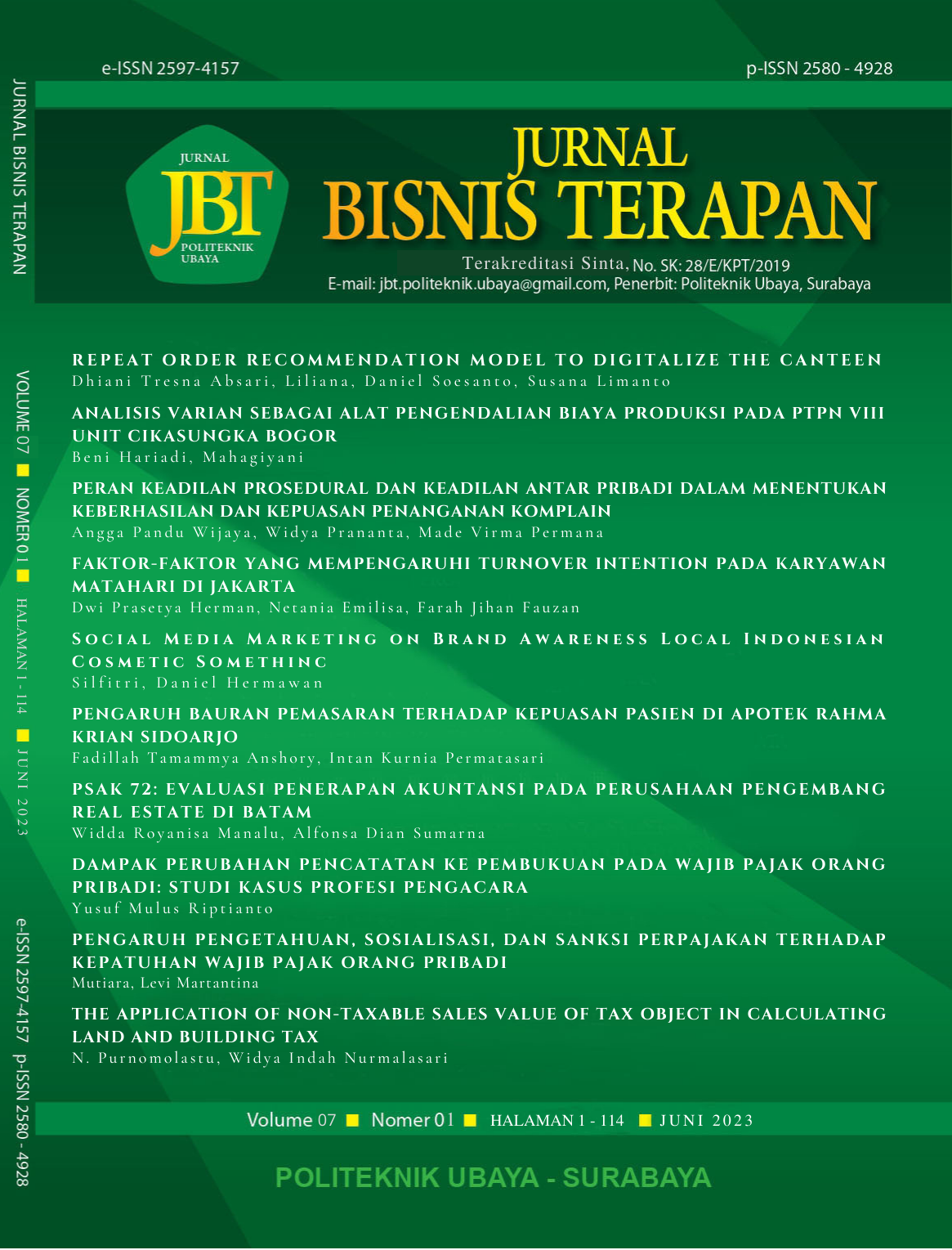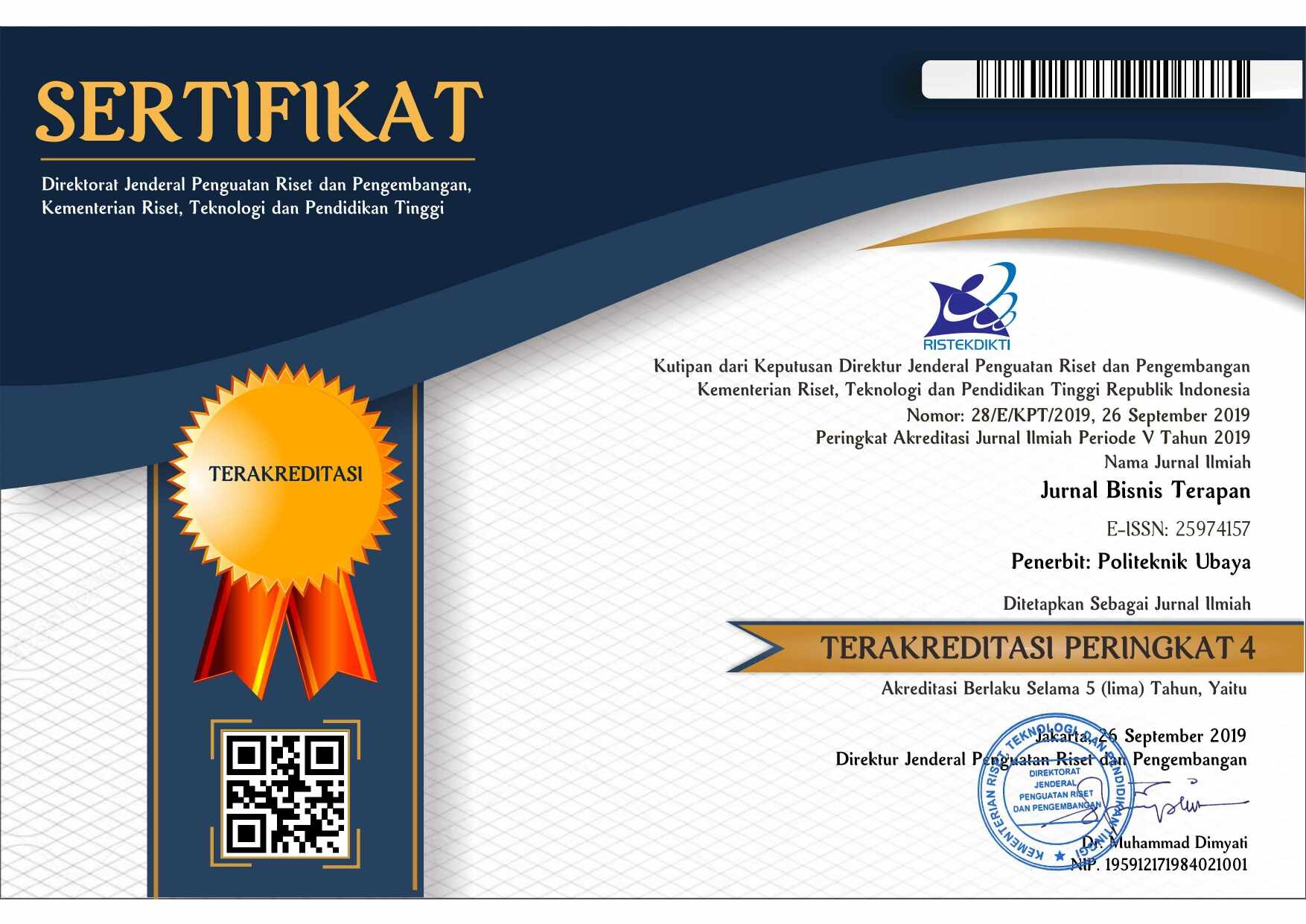REPEAT ORDER RECOMMENDATION MODEL TO DIGITALIZE THE CANTEEN
 Abstract Views:
520 times
Abstract Views:
520 times
 PDF Downloads:
382 times
PDF Downloads:
382 times
Abstract
The canteen is a campus facility that the academic community needs. However, because it is considered a complementary facility, business processes in the canteen are carried out conventionally, relying on paper-based recording. In addition, at certain hours, especially at lunchtime, the canteen is overloaded due to too many orders co-occurring. This buildup of charges is due to the need for canteen preparation in preparing orders from its buyers. Therefore, this study developed an ordering system to recommend the menus that customers likely purchase. The case study used in this research is the Keluwih canteen on the Tenggilis campus, owned by the University of Surabaya. This research used the waterfall method and focused on three main canteen processes: online ordering with a repeat order recommendation model for sellers, delivery services, and payments using the e-wallet. The study's results were assessed qualitatively, and the respondents felt they got better and faster service. Furthermore, with this system's e-canteen application, the time needed to complete a transaction at the campus canteen can be done efficiently to increase customer satisfaction and employee productivity from tenants.
Downloads
References
Alejandro, V., Salim, C., & Jonathan, B. (2019). A proposed model of e-learning tools acceptance among university students in developing countries. Education and Information Technologies, 1057–1071.
Andre. (2020). Onthel. In Universitas Surabaya. http://repository.ubaya.ac.id/40883/
Andri, A., Robin, R., & Ridho, M. (2019). Pengembangan Aplikasi E-Kantin Berbasis Mobile Dan Web. Jurnal Mahajana Informasi, 4(2), 43–49. http://e-journal.sari-mutiara.ac.id/index.php/7/article/view/962
Azzuhri, A. A., Syarafina, A., Yoga, F. T., & Amalia, R. (2018). A Creative, Innovative, and Solutive Transportation for Indonesia with Its Setbacks and How to Tackle Them: A Case Study of the Phenomenal GOJEK. Review of Integrative Business and Economics Research, 7(1), 59–67. https://www.sibresearch.org/uploads/3/4/0/9/34097180/riber_7-s1_sp_h17-051_59-67.pdf
Calista, B., Absari, D. T., & Liliana, L. (2022). Pembuatan Aplikasi Pemesanan Makanan dan Minuman Secara Online Pada Kantin Keluwih Universitas Surabaya. Universitas Surabaya.
Chen, J., Wang, C., Wang, J., & Yu, P. S. (2016). Recommendation for Repeat Consumption from User Implicit Feedback. IEEE Transactions on Knowledge and Data Engineering, 28(11), 3083–3097. https://doi.org/10.1109/TKDE.2016.2593720
Cilliers, E. J. (2017). the Challenge of Teaching Generation Z. PEOPLE: International Journal of Social Sciences, 3(1), 188–198. https://doi.org/10.20319/pijss.2017.31.188198
Dangmei, J., & Singh, A. P. (2016). Understanding the Generation Z: the Future Workforce. South -Asian Journal of Multidisciplinary Studies, 246(3), 2349–7858. https://www.researchgate.net/publication/305280948
Dermawan, R. C., & Masya, F. (2020). Analisa Dan Perancangan Desain Antarmuka Pengguna Dan Menggunakan Konsep SWOT Untuk Optimalisasi Pelayanan Kantin. 2, 525–539. https://jurnal.ikhafi.or.id/index.php/jusibi/article/view/226
Dybka, P. (2020). Crow’s Foot Notation. Vertabelo SA. https://www.vertabelo.com/blog/crow-s-foot-notation/
Fonggo, F., Beng, J. T., & Arisandi, D. (2020). Web-based canteen payment and ordering system. IOP Conference Series: Materials Science and Engineering, 1007(1). https://doi.org/10.1088/1757-899X/1007/1/012159
Gunawan, H., Sinaga, B. L., & Sigit Purnomo, W. P. (2019). Assessment of the readiness of micro, small and medium enterprises in using E-money using the unified theory of acceptance and use of technology (UTAUT) method. Procedia Computer Science, 161, 316–323. https://doi.org/10.1016/j.procs.2019.11.129
Heeagera, L. T., & Nielsen, P. A. (2018). A Conceptual Model of Agile Software Development in A Safety-Critical Context: A Systematic Literature Review. Information and Software Technology, 103, 22–39. https://www.sciencedirect.com/science/article/abs/pii/S0950584918301125
Liliana, L., Absari, D. T., & Benaly, F. B. (2020). Pengembangan Aplikasi Retail Dengan Sistem Konfigurasi. Teknika, 9(2), 156–162. doi: 10.34148/teknika.v9i2.305
Masrul, Leon A. Abdillah, Tasnim, Janner Simarmata, Daud Oris Krianto Sulaiman, Cahyo Prianto, Muhammad Iqbal Agung Purnomo, Febrianty, D. H. S. (2020). Social Distancing dan Budaya Kita. Pandemik COVID-19 Persoalan Dan Refleksi, May, 39–47. https://www.researchgate.net/publication/341218892
Maze. (2020). Maze. https://maze.co/platform/user-testing/
Mufidah, E. A. (2020). Efektivitas Layanan Khusus Kantin Digital ( E- Canteen ) Dalam Meningkatkan Digital Quotient Siswa. Jurnal Inspirasi Manajemen Pendidikan, 8, 517–531. https://ejournal.unesa.ac.id/index.php/inspirasi-manajemen-pendidikan/article/view/37653
Neyfa, B. C., & Tamara, D. (2016). Perancangan Aplikasi E-Canteen Berbasis Android Dengan Menggunakan Metode Object Oriented Analysis & Design ( OOAD ). Jurnal Penelitian Komunikasi Dan Opini Publik, 20(1), 83–91. https://doi.org/10.1136/bmj.1.6001.107
Nidhra, S. (2012). Black Box and White Box Testing Techniques - A Literature Review. International Journal of Embedded Systems and Applications, 2(2), 29–50. https://doi.org/10.5121/ijesa.2012.2204
Nugroho, A. C., Putra, G. R., & Fitriati, D. (2019). Implementasi e-Kantin di Fakultas Teknik Universitas Pancasila. Seminar Nasional Teknologi Informasi, 2, 301–306. http://prosiding.uika-bogor.ac.id/index.php/semnati/article/view/310
Priporas, C. V., Stylos, N., & Fotiadis, A. K. (2017). Generation Z consumers’ expectations of interactions in smart retailing: A future agenda. Computers in Human Behavior, 77, 374–381. https://doi.org/10.1016/j.chb.2017.01.058
Purnama, S., Hafizd, K. A., & Rabini Sayyidati. (2020). Sistem Informasi Kantin Elektronik (E-CANTEEN) Politeknik Negeri Tanah Laut Berbasis Web Mobile. ANTIVIRUS: Jurnal Ilmiah Teknik Informatika, 14(2), 73–85. https://ejournal.unisbablitar.ac.id/index.php/antivirus/article/view/1124
Ramadhan, B. I., & Pradekso, T. (2020). Hubungan Antara Terpaan Iklan Aplikasi Halodoc dan Terpaan Persuasi Reference Group Dengan Minat untuk Menggunakan Aplikasi Halodoc Sebagai Sarana Konsultasi dengan Dokter. Interaksi Online, 9(1), 130–140. https://ejournal3.undip.ac.id/index.php/interaksi-online/article/view/29579
Randita, Tobing, F. B., & Sidharta, J. (2019). Hubungan Kepuasan Mahasiswa FE Terhadap Fasilitas dan Kinerja Dosen FE di Universitas Kristen Indonesia. Fundamental Management Journal, 1(3), 29–39. http://ejournal.uki.ac.id/index.php/jm/article/view/245
Recker, J. (2008). BPMN Modeling - Who, Where, How and Why. BPTrends. https://eprints.qut.edu.au/12317/%0A?c
Rombe, Y. (2020). Strategi Meningkatkan Kualitas Layanan Melalui Digitaliasi Jasa Perbankan Di PT . Bank Negara Indonesia. 4, 34–44.
Shatto, B., & Erwin, K. (2016). Moving on From Millennials: Preparing for Generation Z. The Journal of Continuing Education in Nursing, 47(6), 253–254. https://doi.org/10.3928/00220124-20160518-05
Smith, K. T. (2019). Mobile advertising to Digital Natives: preferences on content, style, personalization, and functionality. Journal of Strategic Marketing, 27(1), 67–80. https://doi.org/10.1080/0965254X.2017.1384043
Solikin, S. (2019). Supervisi Manajemen Layanan Kantin Sehat Di Sekolah Adiwiyata (Studi Kasus Di Smpn 3 Sampang Dan Smpn 1 Ketapang Kab. Sampang). Re-JIEM (Research Journal of Islamic Education Management), 2(2), 240–251. https://doi.org/10.19105/re-jiem.v2i2.2751
Syahril, W. N., & Rikumahu, B. (2019). Penggunaan Technology Acceptance Model (TAM) Dalam Analisis Minat Perilaku Penggunaan E-Money Pada Mahasiswa Universitas Telkom. Jurnal Mitra Manajemen, 3(2), 201–214. https://doi.org/10.52160/ejmm.v3i2.201
Taipale, S. (2016). Synchronicity matters: defining the characteristics of digital generations. Information Communication and Society, 19(1), 80–94. https://doi.org/10.1080/1369118X.2015.1093528
Wu, J., Li, Y., Shi, L., Yang, L., Niu, X., & Zhang, W. (2022). ReRec: A Divide-and-Conquer Approach to Recommendation Based on Repeat Purchase Behaviors of Users in Community E-Commerce. Mathematics, 10(2). https://doi.org/10.3390/math10020208


This work is licensed under a Creative Commons Attribution-NonCommercial-ShareAlike 4.0 International License.

Ciptaan disebarluaskan di bawah Lisensi Creative Commons Atribusi-NonKomersial-BerbagiSerupa 4.0 Internasional.
-
Articles published in Jurnal Bisnis Terapan are licensed under a Creative Commons Attribution-NonCommercial-ShareAlike 4.0 International (CC BY-NC-SA 4.0) license, which permits anyone to copy, transform, or redistribute articles for any lawful purpose in any medium, provided appropriate credit is given to the original author(s) and Jurnal Bisnis Terapan is recognized as its original publisher. A link to this license should also be provided. Any derivative work of an article published in Jurnal Bisnis Terapan must also be shared under the same (or compatible) license.
-
Both copyright and publishing rights on articles are retained by the respective author(s), without restrictions. Only a non-exclusive license is granted to Jurnal Bisnis Terapan to publish the article and identify itself as its original publisher.

 DOI:
DOI:






